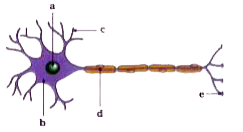The information acquired at the end of the dendritic tip sets off a chemical reaction. This creates an / a a action b reaction c electrical impulse d potential
c An action potential is a spike of electrical discharge that travels along the membrane of a cell.
Related Solutions
Dendrites transmit chemical impulse towards the cyton.
View SolutionWhich of the following statement is correct. (A) The electrical potential difference across the polarised plasma membrane is called as action potential in resting stage. (B) Na^+ ion is responsible for generating an action potential. (C) The impulse is action potential
View Solutionकिसी अभिक्रिया के रासायनिक बलगतिकी आँकड़ो से ज्ञात होता है कि इस अभिक्रिया कि दर है। यही यह क्रिया निम्न पदों में होती है-
(i) (ii) (iii)
तो इस अभिक्रिया का दर निर्धारक पद-View SolutionThe potential difference is created in a cell ........... (due to chemical reaction/using a generator)
View SolutionIdentify the parts of a neuron in a diagram :
(1) where information is acquired,
(2) through which information travels as electrical impulse, and
(3) where this impulse in must be converted into a chemical signal for onward transmission.
 View Solution
View SolutionName the parts of a neuron
(i) Where information is acquired
(ii) through which information travels as an electrical impulse.
(iii) Where this impulse must be converted into a chemical signal for onward transmission.View Solutiona] Give the location of gustatory receptor and olfactory receptor present in human beings. b] Write a and b in the given flow chart of neuron through which information travels as an electrical impulse. "Dendrite"rarrararrb End point of Neuron
View SolutionThrough whom does the impulse enter into the cyton? a. Dendrite b. Axons c. Both A and B d. None of the given
View SolutionIn the reaction sequences

A,B,C and D are given by the set:View SolutionIn the reaction sequences

A,B,C and D are given by the set:View Solution{:(1.,"Neuroglia",-,(a)" Conduct nerve impulses"),(2.,"Electrical impulse",-,(b)" Connects the lobe of cerebellum"),(3.,"Pons",-,(c)" Cerebrospinal fluid"),(4.,"Brain",-,(d)" Do not conduct nerve impulses"),(5.,"Dendrites",-,(e)" Information from the receptor"):}
View SolutionThe process of responding to peripheral nerve stimulation that occurs involuntarily is referred to as (a) Reflex action (b) Action potential (c) Nerve impulses (d) Co - ordination
View Solutionतन्त्रिका कोशिका में विद्युत आवेग द्रूमिका/डेन्ड्राइट (Dendrite) से कहाँ तक जाता है ?
View SolutionRead the following event of impulse. (a) Generation of Threshold potential (b) Generation of Action potential (c) Depolarisation initiates (d) Generation of graded potential Choose the correct sequence of impulse :-
View SolutionRead the following event of impulse. (a) Generation of Threshold potential (b) Generation of Action potential (c) Depolarisation initiates (d) Generation of graded potential Choose the correct sequence of impulse :-
View SolutionConsider that you are passing by a garbage disposal area and you immediately cover your nose. Arrange the events belown in a logical order by marking them from (i) to (v) to trace the events that happen in the nervous system from detection of foul smell (stimulus generation) to covering your nose (response). (i) At the end of the axon, electrical impulse releases chemicals. (ii) Stimulus received by the dendritic cells of a neuron sets off chemical reaction that creates an electrical impulse. (iii) Electrical impulse transmitted through cell body and axon. (iv) The chemicals cross the synapse and reach the next neuron. Similarly, the electrical impulse crosses several neurons. (v) Finally, the impulse is delivered from neuron to the gland that helps in recognition of the foul smell and muscle cells that help in covering the nose.
View SolutionConsider that you are passing by a garbage disposal area and you immediately cover your nose. Arrange the events belown in a logical order by marking them from (i) to (v) to trace the events that happen in the nervous system from detection of foul smell (stimulus generation) to covering your nose (response).
(i) At the end of the axon, electrical impulse releases chemicals.
(ii) Stimulus received by the dendritic cells of a neuron sets off chemical reaction that creates an electrical impulse.
(iii) Electrical impulse transmitted through cell body and axon.
(iv) The chemicals cross the synapse and reach the next neuron. Similarly, the electrical impulse crosses several neurons.
(v) Finally, the impulse is delivered from neuron to the gland that helps in recognition of the foul smell and muscle cells that help in covering the nose.View SolutionThe dendrite carries impulses
View Solutionडेन्ड्राइट आवेग ले जाते है-
View SolutionThe dendrite carries impulses
View Solution
